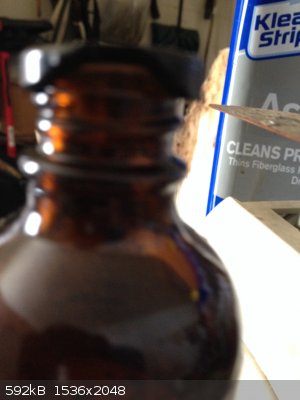dactyl
Unregistered
Posts: N/A
Registered: N/A
Member Is Offline
|
|
bottle bursting o-toluidine
Early this morning, I went to my garage and noticed a manure odor which I found odd.
I looked on the floor and found an upright bottle which I recall was placed on top of a bench. The spill was around the bottle in a circular
distribution but more of the liquid was around the left side of the bottle. Putting paper on this spill resulted in absorbing a brown liquid which
smelt like horse manure which is consistent with the o-toluidine. The cap was located a foot away and looked vastly deformed and shortened.
I will put photos of the cap and parts of the spill.
What types of impurities in o-toluidine might result in bursting out of bottles? The msds and chemicalbook.com suggest storage in a cool,
well-ventilated place which is what I currently have.


|
|
|
Praxichys
International Hazard
    
Posts: 1063
Registered: 31-7-2013
Location: Detroit, Michigan, USA
Member Is Offline
Mood: Coprecipitated
|
|
Oxidation from storage under air probably kick-started polymerization, which releases hydrogen. It's a common problem with aryl amines, which is why
they turn a nasty red/brown color on storage. IIRC toluidines are straw colored liquids when pure, not brown.
|
|
|
dactyl
Unregistered
Posts: N/A
Registered: N/A
Member Is Offline
|
|
Preparing o-toluidine from iron and HCl does result in a brown colored liquid if I recall.
Which makes me think during the exothermic reaction the polymerization starts.
Do zinc or tin oriented preparations undergo this?
If a put my o-toludine under -10 C can I prevent bursting and am I right to say that if my bottle has been openly exposed to air for hours the
o-toluidine is very impure?
Thanks
|
|
|
Praxichys
International Hazard
    
Posts: 1063
Registered: 31-7-2013
Location: Detroit, Michigan, USA
Member Is Offline
Mood: Coprecipitated
|
|
I'm not sure about the Zn or Sn versions of the reaction, but I would pick the cheapest/highest yield out of those and focus more on cleaning up and
stabilizing the product.
The customary purification method is to steam distill the toluidine from the reduction residues, then extract it with a low-boiling solvent. This
extract is dried over K2CO3 (any non-acidic drying agent should work) and then distilled to recover the low-boiling solvent, and finally
vacuum-distilled to collect the toluidine, freeing it from residual drying agent/polymerization products. The product will be very light in color and
should store well.
After long-term storage, if discoloration occurs, redistill it (vacuum) over a small amount of zinc dust. The main storage concerns are to avoid high
temperatures, exposure to light, exposure to oxygen, and especially to eliminate traces of any transition metals that may be present from the
reduction.
More detailed versions of what I have described (and some alternatives) can be found under the "aniline" preparation from Vogel's Practical Organic
Chemistry, 3rd Ed. from the ScienceMadness Library, and the following thread: http://www.sciencemadness.org/talk/viewthread.php?tid=7150
|
|
|
Magpie
lab constructor
    
Posts: 5939
Registered: 1-11-2003
Location: USA
Member Is Offline
Mood: Chemistry: the subtle science.
|
|
I would think it takes a lot of pressure (several bar?) to burst a phenolic or even a polyethylene cap. I'm surprised that the H2 just didn't leak
past the threads.
I going to place my aryl amines in a secondary container. Thanks for this post.
The single most important condition for a successful synthesis is good mixing - Nicodem
|
|
|
Texium
Administrator
       
Posts: 4618
Registered: 11-1-2014
Location: Salt Lake City
Member Is Offline
Mood: PhD candidate!
|
|
On a semi related note, would distilling commercial, brownish aniline under partial vacuum be an effective way to purify it, or would full vacuum be
necessary to do any good?
|
|
|
gdflp
Super Moderator
      
Posts: 1320
Registered: 14-2-2014
Location: NY, USA
Member Is Offline
Mood: Staring at code
|
|
I've distilled aniline under a weak vacuum(~120torr) before and it cleaned it up quite nicely. Distilling over a little zinc dust helps as well.
|
|
|
Praxichys
International Hazard
    
Posts: 1063
Registered: 31-7-2013
Location: Detroit, Michigan, USA
Member Is Offline
Mood: Coprecipitated
|
|
I think any amount of vacuum is going to help. 200°C is pretty hot.
Vogel's aniline prep does not call for vacuum and instructs to collect product from 180 to 184°C, and this product is apparently of suitable purity.
You might be able to get away with plain distillation of o-toluidine but I think the main issue will be tars in the still pot adhering fairly strongly
after seeing more than 200°C.
Purification of Laboratory Chemicals (W.L.F. Armarego, 8th ed.) insists that it should be done under partial pressure of nitrogen. I
doubt Vogel's method included modern analysis techniques, so the aniline was likely checked only by MP or something. It's hard to say how much purity
there is to be gained this way.
Regardless, it can be assumed that an inert purge will help prevent oxidation at elevated temperatures, and reduced temperature (by reducing pressure)
helps overall.
|
|
|
Amos
International Hazard
    
Posts: 1406
Registered: 25-3-2014
Location: Yes
Member Is Offline
Mood: No
|
|
Steam-distilling toluidines with mildly alkaline water has always done me good; the distillate is always a light straw or peach color.
|
|
|
dactyl
Unregistered
Posts: N/A
Registered: N/A
Member Is Offline
|
|
Are the polymers responsible for the manure odor? Vogel is silent on that matter.
|
|
|
Niki0beas
Harmless

Posts: 1
Registered: 11-6-2017
Member Is Offline
Mood: No Mood
|
|
How did this happen.
|
|
|